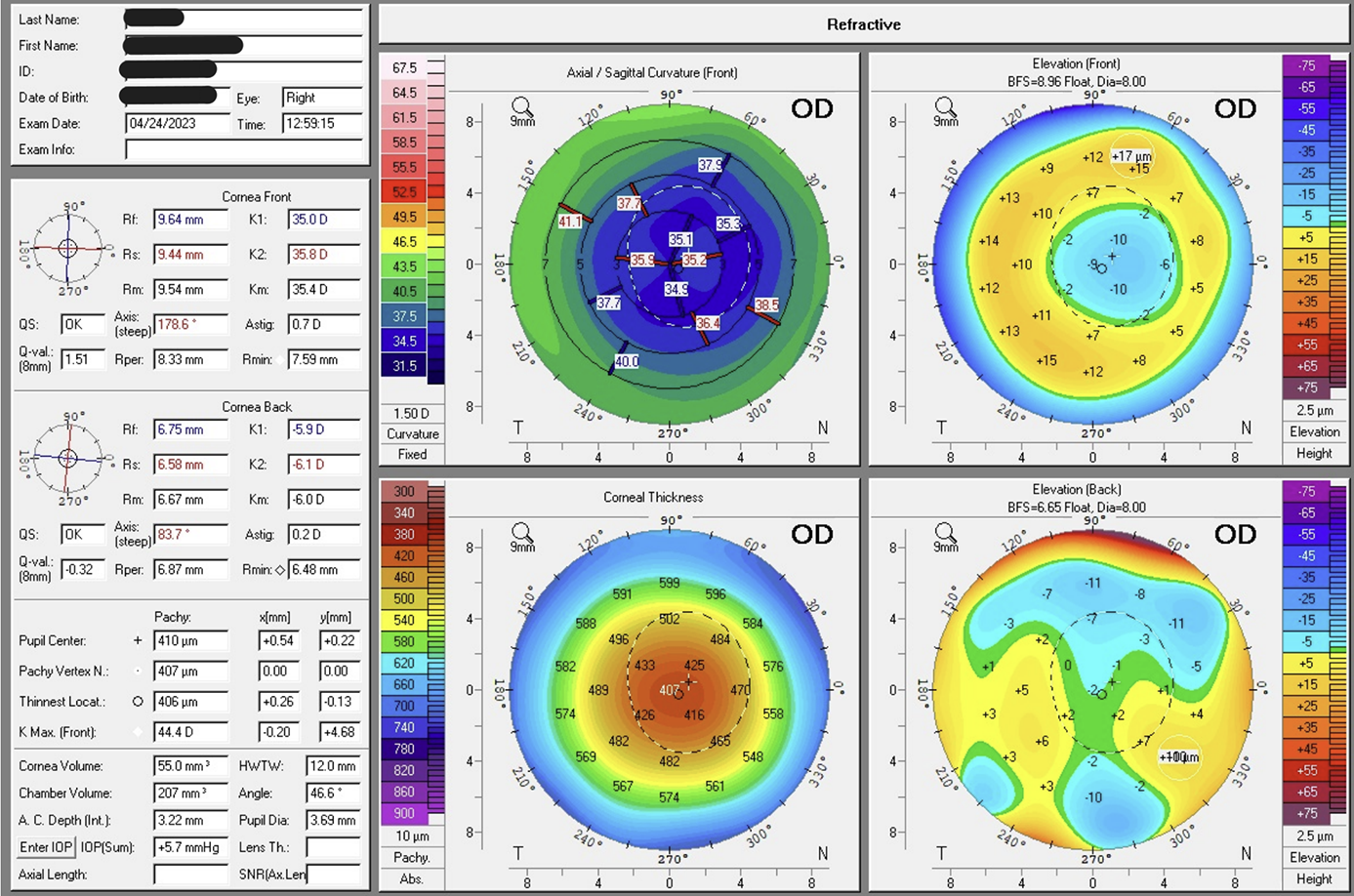How to SMILE with a challenging patient – Reaping the speed of the VISUMAX 800 femtosecond laser
We have been performing Lenticule Extraction with ZEISS SMILE using the ZEISS VisuMax femtosecond laser (Carl Zeiss Meditec AG; Jena, Germany) to treat myopia and myopic astigmatism since 2012, and it is our preferred procedure for any myopic patient who is a candidate for a laser refractive procedure. In October 2021, the next generation ZEISS VISUMAX 800 became commercially available, and we have used this new laser to perform Lenticule Extraction with ZEISS SMILE pro in approximately 1200 eyes.
The ZEISS VISUMAX 800 features several enhancements compared with its predecessor that contribute to surgical workflow efficiency, including digital aids for centration (CentraLign®) and to facilitate cyclotorsion alignment (OcuLign®). The device also has a smaller footprint, separate laser and microscope arms, and uses heads-up docking. Faster pulse frequency, however, is the leading difference distinguishing the ZEISS VISUMAX 800 from its predecessor. Operating at a pulse frequency of 2 MHz, the ZEISS VISUMAX 800 completes lenticule creation in less than 10 seconds* compared to 25 seconds* when the procedure is performed with the 500 kHz ZEISS VisuMax laser.
The reduction in lenticule creation time using the ZEISS VISUMAX 800 is noteworthy considering that movement of the head, eye, and eyelids during this step can result in loss of suction.1 Even patients who are convinced that ZEISS SMILE is the right solution for correcting their ametropia might wonder if they will be able to keep still for 25 seconds. Such worries are usually adequately addressed with proper education during the consultation visit, and verbal coaching intraoperatively is generally effective for achieving the necessary patient cooperation. Nevertheless, as seen in the following case, patient nervousness can sometimes resurface on the day of surgery. At the same time, this patient’s case provides testament to the speed and ease of ZEISS SMILE pro using the ZEISS VISUMAX 800 femtosecond laser.
Case history
A 39-year-old gentleman presented at our Bangalore facility wanting to be treated with ZEISS SMILE pro Lenticule Extraction for refractive correction. He lived in London and told us that he came to India to have the procedure because his friend, who we had treated with this procedure a few months earlier, recommended our center. On examination, the patient’s refraction was -7.70 -0.55 D @ 65° OD and -7.45 -0.50 @ 110° OS. His BSCVA was 6/6 OU.
Other diagnostic findings, including topography and central corneal thickness, showed he was a suitable candidate for ZEISS SMILE pro (Figure 1).
Figure 1. Preop topography, OD

Figure 2. Postop topography (2 weeks), OD

Typical of many refractive surgery candidates, this patient had done a lot of research prior to his visit. However, the number of questions he was asking and the level of detail that he was seeking about every step of the procedure were extreme. The patient also seemed to have extraordinarily high expectations for his surgical outcome, which raised some concern that he might be dissatisfied regardless of the results. However, considering our experience with Lenticule Extraction and because the patient was an excellent candidate from an ophthalmic standpoint, I felt comfortable scheduling the surgery. On the day of the procedure after the first eye was prepped and draped, the patient became extremely anxious as soon as he laid down under the laser. His constant eye movement caused the initial docking attempts to fail, and the patient was unable to remain still. His face was covered with sweat, he was having difficulty breathing, he wanted to be given an anxiolytic medication, and he even asked if he could undergo the surgery under general anesthesia. I explained the latter was not possible, removed the speculum, wiped the sweat from his face, and reassured the patient that I was confident the procedure would go well and that he would have a good outcome, but he needed to follow my instructions and remain still. The patient regained composure after a few minutes, and we started again. Centration was easy and quick using the laser’s digital centration aid, docking was completed without incident, the patient remained still for the short time needed to create the lenticule, and lenticule dissection and removal were successfully completed.
The laser treatment took only 9 seconds, and as soon as the steps for the first eye procedure were finished, the patient remarked that it was much simpler and faster than he expected. He observed that his earlier reaction stemmed from fear of the unknown. Supported by his knowledge of the actual experience, the patient was comfortable proceeding immediately with the second eye treatment that was completed successfully without any interruptions. The patient was seen before he returned to London at 2 weeks postsurgery (Figure 2). His UCVA was 6/6 OU.
Discussion
Lenticule Extraction with ZEISS SMILE pro has been our preferred laser refractive surgery for correcting myopia/myopic astigmatism because of its excellent outcomes and advantages we believe it offers compared with LASIK.2-4 Anecdotally, the refractive and functional results of our ZEISS SMILE pro cases performed after we began using the ZEISS VISUMAX 800 have been as good as those we achieved using the ZEISS VisuMax laser, and our experience is consistent with that reported by Reinstein et al. in a recently published paper.5
Achieving excellent results when operating on patients who are nervous and anxious does require increased attention to preoperative education and guidance during surgery so that these individuals will remain calm and keep their head and eyes still. Shortening of the lenticule creation time using the ZEISS VISUMAX 800 was an important benefit when operating on this anxious patient. The fact that he was being treated for relatively high myopia made no difference to the lenticule creation time, which is generally independent of prescription magnitude. Docking could also be accomplished quickly in this case involving a nervous patient because time needed to achieve proper centration of the dock is decreased using the ZEISS VISUMAX 800 with the help of the laser’s centration aid. As proposed by Reinstein et al., the decrease in laser treatment time achieved using the ZEISS VISUMAX 800 might have an additional benefit for reducing the chance of suction loss.5 In discussing this idea, these authors referred to a study in which they reported a suction loss incidence of 0.5% in a series of 4000 eyes that underwent ZEISS SMILE Lenticule Extraction with the ZEISS VisuMax laser.6 Extrapolating from their finding that 65% of the suction loss events occurred after the 10 seconds creating the lenticule interface, Reinstein et al. suggested that use of the ZEISS VISUMAX 800 might reduce the incidence of suction loss by 65%.5
Other investigators report that the suction loss rate during ZEISS SMILE performed with the ZEISS VisuMax laser ranges from 0.17% to 5.06%.1 Using the ZEISS VISUMAX 800 laser we had just a single case of suction loss among the 1200 eyes treated so far, representing a rate of 0.08%. It remains to be seen what suction loss rates other clinics will report in the future.
Conclusion
In my opinion, as the successor to the ZEISS VisuMax femtosecond laser, the ZEISS VISUMAX 800 brings several advancements that make ZEISS SMILE pro easier for surgeons and patients. Faster speed for lenticule creation is key among the new features. Consequently, even patients who are somewhat anxious may feel more confident going into the procedure about their ability to keep their head and eyes still as needed and be successful doing so during the procedure. In addition, surgeons who have been reluctant to adopt ZEISS SMILE into their practice due to concern about maintaining patient cooperation may feel more comfortable performing Lenticule Extraction with the ZEISS VISUMAX 800 laser, even in the challenging situation of an anxious patient.
Watch the video to get a detailed insight into Dr. Sheetal Brar´s case

Dr. Sheetal Brar is a senior consultant at Nethradhama Super Specialty Eye Hospital, Bangalore, India. She is a consultant to Carl Zeiss Meditec AG.
References:
1 Huang TZ, Shen L, Yu XN, Jin HY. Risk factors and incidence of suction loss during small incision lenticule extraction (SMILE) in 8493 eyes. BMC Ophthalmol. 2020;20(1):412.
2 Shah R. History and results; indications and contraindications of SMILE compared with LASIK. Asia Pac J Ophthalmol (Phila). 2019;8(5):371-376.
3 Guo H, Hosseini-Moghaddam SM, Hodge W. Corneal biomechanical properties after SMILE versus FLEX, LASIK, LASEK, or PRK: a systematic review and meta-analysis. BMC Ophthalmol. 2019;19(1):167.
4 Denoyer A, Landman E, Trinh L, Faure J-F, Auclin F, Baudouin C. Dry eye disease after refractive surgery: comparative outcomes of small incision lenticule extra ction versus LASIK. Ophthalmol. 2015;122(4):669-76
5 Reinstein DZ, Archer TJ, Potter JG, Gupta R, Wiltfang R. Refractive and visual outcomes of SMILE for compound myopic astigmatism with the VISUMAX 800. J Refract Surg. 2023;39(5):294-301.
6 Reinstein DZ, Archer TJ, Vida RS, Carp GI. Suction stability management in small incision lenticule extraction: incidence and outcomes of suction loss in 4000 consecutive procedures. Acta Ophthalmol. 2020;98(1):e72-e80.
*Conditions for VisuMax and VISUMAX 800: myopia with optical zone 6.5 mm, spot distance 4.5 μm, track distance 2.0 μm

